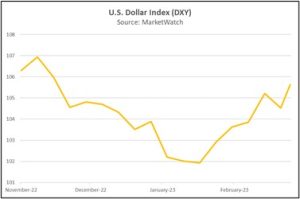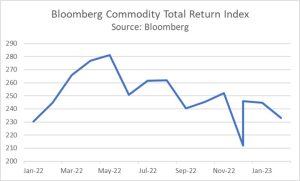Daily Comment (March 9, 2023)
by Patrick Fearon-Hernandez, CFA, and Thomas Wash
[Posted: 9:30 AM EST] | PDF
Good morning! Today’s Comment begins with a discussion about the growing appeal of the U.S. dollar. Next, we examine what the potential impact could be for companies as governments move away from neoliberal policies. Finally, we review why the recent decline in commodity indexes should not dampen investor outlook on the sector.
The Dollars Back: Hawkish talk from Federal Reserve Chair Jerome Powell has investors piling back into the greenback.
- The ICE U.S. Dollar Index surged to its highest level since November 2022 after Powell signaled that recent economic data could encourage the Fed to set rates even higher than it outlined in its latest dot plots. Powell attempted to calm markets by stating that the Fed has not yet made a final decision. However, the 30-day fed funds futures market is now forecasting a 46% chance that the central bank could raise rates an additional 125 bps by the end of July. Doubts about whether other central banks will follow suit have also supported the dollar.

- The European Central Bank is expected to raise rates by 50 bps in its next meeting later this month, but it isn’t clear where policy will go after that. Head of the Italian Central Bank Ignazio Visco criticized members of the ECB’s rate-setting governing council for pushing for additional rate hikes despite agreements that policy would be determined meeting-by-meeting. The uncertainty for the future of ECB policy raises the likelihood of a greater depreciation of the euro. The currency has fallen 1.5% against the dollar over the last three days, and it accounts for about 58% of the dollar index.
- Meanwhile, speculation that the Bank of Japan will maintain its accommodative monetary policy at its next meeting has also put pressure on the yen. The central bank is set to meet today and is expected to leave policy unchanged while the central bank transitions to its new leadership in April. By keeping policy loose, especially while the Fed tightens, the BOJ will make the yen less attractive to international investors which would add upward pressure on the greenback. This trend may conclude if incoming BOJ chief Kazuo Ueda signals a policy shift or if current central bank head Haruhiko Kuroda surprises markets by widening the band around the 10-year yield target like he did in December.
The Biden Shuffle: The White House has begun to shift from neoliberal economic policy to a world that favors equity.
- U.S. President Joe Biden is set to unveil his budget proposal on Thursday. The plan likely has no chance of becoming law but will provide a platform for the president to lay out his policy initiatives as he prepares for reelection. His proposal calls for increased taxes for the wealthy and corporations, incentives to boost domestic manufacturing jobs, and protections for elderly healthcare. The White House estimates that the plan could generate $3 trillion in deficit reductions. His bill appears to be aimed at making his Republican counterparts look out of touch as they prepare a budget proposal that includes changes to the social safety net.
- The Inflation Reduction Act continues to attract more foreign businesses to the U.S. Volkswagen announced that it has put its plan to build a battery plant in Eastern Europe on hold as it analyzes the European Union’s counteroffer. The car manufacturer estimates that the American initiative could net the company between €9 and €10 billion in subsidies and loans when it builds its battery plant in the U.S. The EU’s decision to offer similar subsidies reaffirms our belief that Washington wants Europe to invest domestically to reduce dependence on Chinese manufacturing. In our view, the Inflation Reduction Act aims to have the U.S. and EU make greater investments in climate change technology to help the West close the gap with market leader and rival China.
- Increased state involvement within the economy in the U.S. and Europe will support domestic incomes but squeeze profit margins in the long-term. On the bright side, the reshoring of manufacturing jobs should lift household earnings. However, higher taxes on corporations will make it harder for firms to be profitable, while the development of national champions may encourage governments to implement trade barriers. In short, the move away from neoliberal policies toward populist initiatives is not favorable for companies with a lot of foreign exposure.
- President Biden’s push for export curbs on semiconductor parts and China’s protection of its climate technology may offer a taste of what the future might hold in a less globalized world.
It’s Complicated: Uncertainty of supply and demand for commodities has made it difficult to gauge the bottom of the market, but the long-run outlook for the sector remains favorable.
- The Chinese economy has still not fully recovered from its COVID lockdowns. While generally seen as a net importer of metals, China is expected to export some of its excess inventory of copper. The decision to offload some of its holdings comes amidst signs that manufacturing and construction activity have not returned to maximum levels. Additionally, there are fears that lockdowns may return as a Chinese city has backed a plan to use lockdown measures to help contain influenza outbreaks. This situation suggests that China is still not fully on its feet and consumer confidence may struggle to return to pre-pandemic levels.
- Supply does not seem to be on the upswing either. At the annual CERAWeek conference, U.S. shale producers admitted that they couldn’t challenge OPEC’s pricing power. They have argued that the industry has lost ground to foreign rivals due to a lack of investment. Oil firms have been pressured to limit spending in order to boost higher returns for shareholders. The lack of U.S. production should provide upward prices as declining rig counts prevent firms from producing more oil.
- The Bloomberg Commodity Total Return Index dropped 11% from its peak in May last year. The decline in the index was related to a drop in Chinese demand, concerns about a possible global recession, and a strengthening of the U.S. dollar. Despite its recent fall from grace, the index has been known to be a hedge against inflation, especially in a less globalized world. Uncertainty within the Middle East and Europe will likely support the assets for the foreseeable future; meanwhile, Chinese demand is still expected to return over the coming months. As a result, we believe there is still much upside for the sector.



